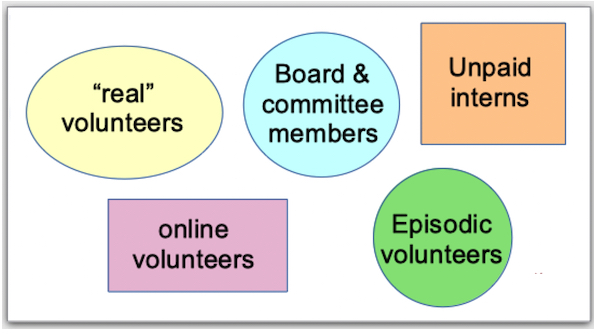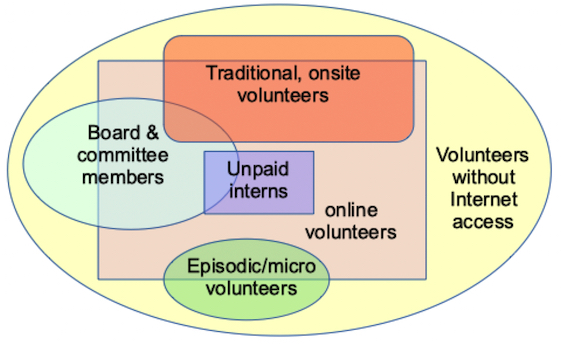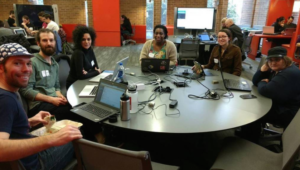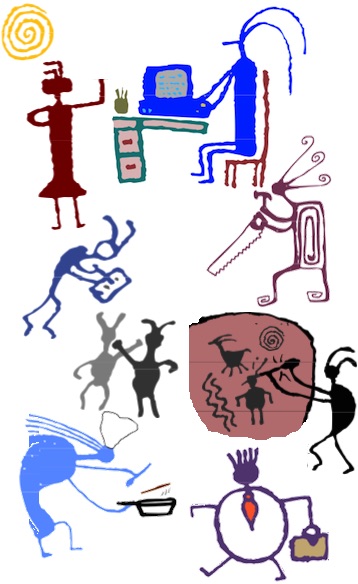 Between my Google Alerts and those whom I follow on Twitter, I see a story at least once a day about the engagement of online volunteers. I put the most interesting or unique ones on the Virtual Volunteering Wiki. It’s so wonderful to see virtual volunteering oh-so-mainstream. I’m not at all surprised: by the 1990s, it was already impossible to track every organization involving online volunteers – there were so many! If there is anyone out there still talking about any form of virtual volunteering – digital volunteers, micro volunteering, crowd sourcing, ework, etc. – as “new”, you have to wonder: have they been under a rock?
Between my Google Alerts and those whom I follow on Twitter, I see a story at least once a day about the engagement of online volunteers. I put the most interesting or unique ones on the Virtual Volunteering Wiki. It’s so wonderful to see virtual volunteering oh-so-mainstream. I’m not at all surprised: by the 1990s, it was already impossible to track every organization involving online volunteers – there were so many! If there is anyone out there still talking about any form of virtual volunteering – digital volunteers, micro volunteering, crowd sourcing, ework, etc. – as “new”, you have to wonder: have they been under a rock?
But I do have a concern: many of these virtual volunteering initiatives don’t seem to have thought about online safety. Too many, in my opinion, are focused on creating a really complex, feature-rich web site for volunteers to use to sign up and contribute their time and skills, but not thinking about risk management – protecting clients and volunteers.
As Susan Ellis and I say in The LAST Virtual Volunteering Guidebook, and I say in any workshop related to virtual volunteering:
Relatively speaking, the Internet is no more or less safe than any other public space, such as a school, faith community, or sports stadium. Fears of exploitation, abuse, or exposure to sexually-explicit or violent material should not prevent an agency from engaging in virtual volunteering, any more than such fears should prevent the involvement of volunteers onsite. There is risk in any volunteering, online or face-to-face. The challenge is to minimize and manage such risk. (page 112)
Do you have to interview every candidate for online volunteering? Do you have to check professional references on every candidate for online volunteering? Do you have to conduct a criminal background check on every online volunteer? No, you don’t have to do any of these things IF the tasks they will do as volunteers don’t warrant such – they aren’t going to work with clients, they aren’t going to work with other online volunteers and know their names, they aren’t going to have access to confidential information, they won’t have access to any online systems in such a way that they could even accidentially harm such, etc. Again, back to a quote from The LAST Virtual Volunteering Guidebook.:
Every organization will have different interview ing and screening methods based on what services volunteers provide and its workplace culture. Even for volunteers working onsite, the issues involved in volunteering for a beach cleanup or simple clerical work are not the same as issues involved in volunteering to tutor young children or manage an organization’s computer systems.
The same is true for online volunteers. Your screening approach will be different for a volunteer designing a Web page than for one creating a private online area where your staff and clients will interact and the online volunteer will have far more access to client contact and other confidential information. (page 41)
If an online volunteering role does warrant some degree of screening – and not all do, but most do – then you have to decide how much there will be, and how it will be conducted. First and foremost is that you must follow the law. For instance, many states require a criminal background check on any volunteers that will work with children one-on-one. A volunteer who will come to a classroom one time to speak about his or her job may not be required by law to undergo a criminal background check, but someone who will talk with a child, one-on-one, even if they will always be in a room with other adults and children, probably is required by law to undergo such – apply the same principles to online volunteers in determining what screening is required. Should the online volunteering candidate be interviewed? If the person is new and is doing any task that requires at least some expertise – web page development, translating text from one language to another, moderating an online discussion group, designing a newsletter, editing a brochure, etc. – yes, absolutely! Many more tips for screening online volunteers to ensure they really can do the task that they have signed up for, and have the time to do so, can be found in The LAST Virtual Volunteering Guidebook.
My favorite resource on screening volunteers, online or offline, that will work with clients in any capacity, is free to download: Screening Volunteers to Prevent Child Sexual Abuse: A Community Guide for Youth Organizations. Point one under the section on what to do before the organization starts screening volunteers is this: “Develop criteria that define how screening information will be used to determine an applicant’s suitability.” That will be different for every organization, depending on their mission and the work volunteers will do. You have to think about not only worst-case scenarios – screening out people that might sexually and/or financially-exploit clients, other volunteers, etc. – but also about people who don’t have the skills necessary for the work, people who don’t have the temperament for the challenges, and people who really don’t have time to volunteer, as all of those scenarios, while not criminal, can be harmful to your organization and those it serves.
You also have to clearly define what behavior is inappropriate on the part of online volunteers, how you will communicate that to volunteers, the consequences of inappropriate behavior, and how you are going to be aware of such behavior. As we note in the guidebook, a way to absolutely ensure safety in online interactions between volunteers and clients is to set up a private system through which all messages are sent, reviewed by staff before they can be read by the intended recipient, stripped of all personal identifying information by the moderator, archived for the record, etc., but that such a system can ruin an attempt to create trusting, caring relationships between volunteers and clients (and we provide a powerful example of how such a super-safe system ended up almost derailing an online mentoring program). Your efforts to ensure safety must balance with your program goals.
Among the many suggestions we make in The LAST Virtual Volunteering Guidebook, regarding online safety is this:
The best way to ensure that clients and volunteers are having positive online experiences is for program staff to stay in frequent touch with both, to encourage an atmosphere of open communication. Also, it is fundamental that you establish and clearly (and frequently) communicate policies regarding online exchanges between volunteers and clients. (page 114)
Clearly, explicitly inform applicants for volunteering about your organization’s policies and procedures regarding safety, abuse prevention, and all aspects of risk management, as well as circumstances that would lead to a volunteer being dismissed. Be explicit. Also share your code of conduct or statement of ethics in writing. Ask applicants if they have a problem with any of the policies and procedures, code of ethics, etc.; such a discussion will help you find out if applicants are uncomfortable with any aspect of such, which can be an indicator that they are an inappropriate candidate. Even though it is not legally binding, require applicants to sign a document that states they understand and agree to adhere to your policies and procedures and code of conduct; again, this can help you find out if an applicant is uncomfortable with any aspect of such, which can be an indicator that they are an inappropriate candidate. It also affirms to volunteers that you make the safety of your volunteers, staff and clients a priority, which can encourage new volunteers to take such precautions with the utmost seriousness.
 There are lots more suggestions and specifics about risk management, online safety, ensuring client confidentiality and setting boundaries for relationships in virtual volunteering in The LAST Virtual Volunteering Guidebook, available both as a traditional printed book and as a digital book. Suggestions for risk management are found throughout the book, in the chapters regarding developing and revising policies, designing assignments for online volunteers, interviewing and screening online volunteers, orienting and training online volunteers, basic techniques for working with online volunteers, and online volunteers working directly with clients, as well as the chapter written for online volunteers themselves. Our advice is based on both virtual volunteering practices, including micro volunteering and crowdsourcing, and the proven fundamentals of onsite, face-to-face, traditional volunteer management.
There are lots more suggestions and specifics about risk management, online safety, ensuring client confidentiality and setting boundaries for relationships in virtual volunteering in The LAST Virtual Volunteering Guidebook, available both as a traditional printed book and as a digital book. Suggestions for risk management are found throughout the book, in the chapters regarding developing and revising policies, designing assignments for online volunteers, interviewing and screening online volunteers, orienting and training online volunteers, basic techniques for working with online volunteers, and online volunteers working directly with clients, as well as the chapter written for online volunteers themselves. Our advice is based on both virtual volunteering practices, including micro volunteering and crowdsourcing, and the proven fundamentals of onsite, face-to-face, traditional volunteer management.
Also see:
Keeping volunteers safe – & keeping everyone safe with volunteers
Why don’t they tell? Would they at your org?
With volunteers, see no evil?
Safety of volunteers contributes to a shelter closing
volunteer managers: you are NOT psychic!
Photos & videos by & of volunteers online – privacy issues?
April 13, 2020 Update: Another new video! I lead virtual volunteering workshops in the 1990s & got big pushback from nonprofits asserting that an online program could never be safe. Now, many programs are launching brand new virtual volunteering programs, bringing online volunteers together with people in senior living homes, or with teens, and on and on. And that change is great, however, these programs need to think about safety! My newest video has more info and is about five-minutes long.
November 16, 2020: The UK Safer Internet Centre is where you can find online safety tips, advice and resources to help children and young people stay safe online. Excellent resource not just for programs in the UK, but ANYWHERE – especially online mentoring, online tutoring and online visiting program where volunteers will assist remote clients.
2021 updates:
Safety in Service Delivery/Client Support by Online Volunteers. Includes guidance regarding online meetings.
Your right to turn away volunteers who won’t adhere to safety measures (& your right to refuse to volunteer at an unsafe program)
My blogs & web pages re: safety in volunteer engagement










